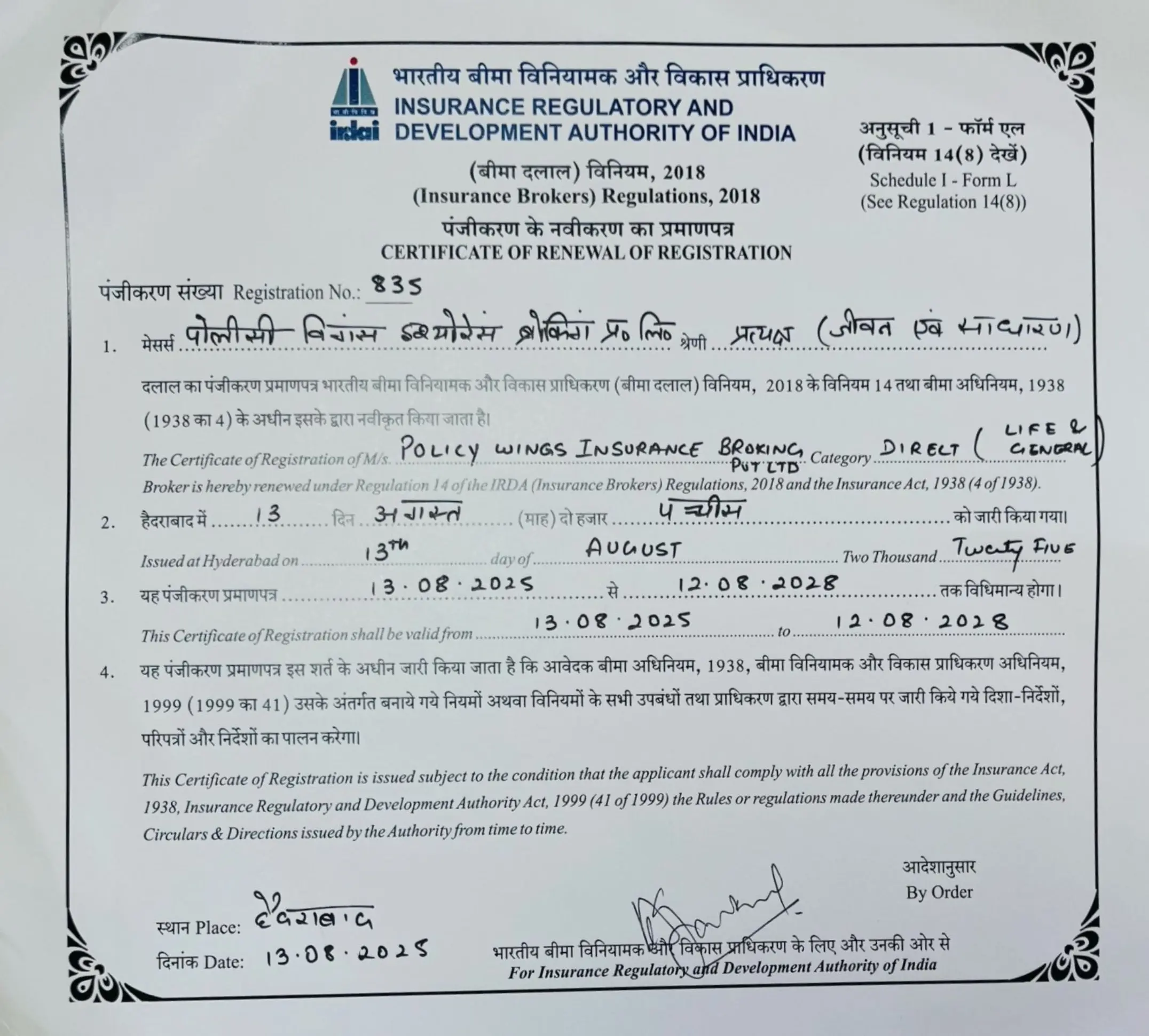Deductibles in Health Insurance
Deductibles in Health Insurance
Understanding the different terminology related to health insurance may seem tricky. Even though these circumstances are crucial to health insurance, they greatly impact the amount of the claim that the insurer would cover. The cost of your hospital stay will be allocated between your insurance provider and you.
You may read the tiny print of health insurance policies to recognise phrases like deductibles, co-pays, and co-insurance. Before choosing a plan, you should be aware of the basic concepts of these health insurance words.
What is Deductible in Health Insurance?
The term ‘deductible’ is closely associated with insurance. It refers to the amount of money that you are obliged to pay in order for the insurance company to pay the remaining amount of the claim.
In health insurance, deductibles prevent you from having to pay unnecessary medical expenses. Due to the fact that the insured is obligated to pay a share of the claim amount with a deductible, they refrain from making claims for minor injuries simply because they are insured.
Deductibles are an essential component of health insurance plans. As a result, there is a balance between the financial responsibility of the policyholder and that of the insurance company while promoting responsible healthcare utilisation.
Individuals are better equipped to manage their healthcare costs by understanding deductibles and their implications.
What is Deductible in Health Insurance? With Example
Health insurance deductibles refer to the amount that an insured must pay before the insurer begins to provide benefits. Therefore, the insurance company is only obligated to pay the claim amount if it exceeds the deductible amount.
Furthermore, if the claim amount is less than the deductible, the insurance company is not required to pay anything. Additionally, high-deductible health insurance policies have low premiums, while policies with low deductibles have higher premiums
For example, you have a health insurance policy of INR 10 lakhs with a deductible of INR 60,000. So, if there is a claim of INR 2 lakhs you have to pay 60,000 and the remaining amount will be paid by the insurance company. But if the claim amount is less than the insurance deductible, the health insurance company is not liable to pay any amount.
Note that health insurance with high deductibles is generally priced at higher premiums and vice versa.
| Claim for INR 2 lakhs | Health Insurance with a Deductible of INR 60,000 | Health Insurance without Deductible |
| Out-of-pocket expenses | INR 60,000 | 0 |
| Insurance Claim payable | INR 1,40,000 | 2,00,000 |
Still unsure? Here’s what you need to know:
All insurance companies impose deductibles to keep policyholders from making small claims. Because they are aware of the fact that they will be responsible for a portion of the claim, it makes them responsible for registering claims.
In this way, unnecessary claims are prevented from being filed, and only genuine claims are filed. If you are considering purchasing health insurance, you should be aware of the deductibles involved.
Why Chose Deductible?
Listed below are some of the major benefits of health insurance deductibles:
- They contribute to the reduction of health insurance premiums. In addition, the insurance company may offer a discount if you have elected to pay a voluntary deductible.
- By discouraging you from submitting small claims, you enhance your chances of earning a No Claim Bonus (NCB), which is used to increase your primary health insurance coverage.
- Health insurance coverage during medical emergencies or unexpected hospitalisations, despite deductibles.
How Do Deductibles Work?
A deductible is a certain amount the insured must pay upfront under their health insurance policy. After paying the total deductible amount the health insurance company starts bearing the medical expenses.
To curb unnecessary claims, health insurance companies introduced deductibles. People often file insurance claims for a relatively small amount merely because they have health insurance coverage. In any case, claims that are unnecessary may reduce their chances of receiving a No Claim Bonus.
A health insurance policy that contains a deductible will compel the insured to file a claim only in the event of a medical emergency, i.e. when the claim amount is high.
Minor medical expenses would not be claimed. As long as the insured pays the deductible first, all unnecessary claims will be eliminated, so the insurance company can honour valid claims.
Deductibles in Top-Up and Super Top-Up Health Insurance Plans:
It is important to note that a top-up health insurance plan or super top-up health insurance plan is the service offered by health insurance companies that allow the insured to enhance the amount of coverage that is available to them.
In the event of unexpected medical conditions, an additional health insurance policy, such as a top-up or super-top-up policy, can be obtained in order to ensure additional coverage for the insured and other family members in the event of an unexpected medical problem.
Having a top-up or super-top-up health insurance policy is a great way to enhance your insurance coverage while maintaining your base sum insured at the same time.
When making a claim under a top-up health insurance policy or super top-up health insurance plan, the insured must pay the deductible amount.
Due to this, only the insured is entitled to file a claim under the top-up policy when the amount of medical treatment exceeds the deductible amount.
Advantages and Disadvantages of Deductibles
Here are some of the advantages of deductibles:
- Mitigated premiums:
Usually, insurance plans intended to expand the reach of current health insurance coverage include deductibles. Insurance companies impose deductibles since they offer these comprehensive plans with a large amount of the allocated funds. The insurers are more likely to provide a plan with a lesser premium with a higher deductible. - Boosted Cost Awareness:
The presence of a deductible makes policyholders more cautious about the healthcare procedures they need. In contrast to more costly treatment, patients usually end up opting for a treatment at a lesser price because a part of the cost needs to be paid by them. - Enhanced insurance capacity:
The No-Claim Bonus amount, which increases the current coverage, is not eligible for insured people who file minor complaints since they are entitled to pay a specific amount toward their hospital expenses. - Flexibility:
For policyholders, deductibles have an element of flexibility (in the event of voluntary deductibles). They have the choice of choosing between a higher deductible and a lesser premium or the reverse.
Here are some of the disadvantages of deductibles:
- Chances of personal savings taking a significant hit:
You might see a large reduction in the amount you save whether you choose a larger deductible to get reduced rates or a higher deductible for a lower premium.
Choose a higher deductible and a super top-up plan as a solution. While you have the benefit of accumulating deductible coverage all throughout the year, you have an improved degree of coverage and a considerably cheaper cost with Super top-ups. - Discouragement from accessing high-end medical treatments:
Policyholders often refuse to use an insurance plan when a deductible is in place. The general consensus is that people shouldn’t opt for financial coverage that requires a high premium if, even after insurance coverage, they still have to make payments out of pocket (without reimbursement).
It is important to remember that while the deductible may appear hefty at first, the overall cost of treatments is typically far greater. Additionally, by paying the low deductible, you may receive expanded coverage to cover your medical costs, providing you with to access premium healthcare. - Having trouble understanding insurance terminology:
The financial terms and circumstances that come with insurance policies are now complex. This is a safeguard on the part of the insurers that ensures that their businesses remain beneficial by using covert gaps in their policies.
The degree of complexity rises further with the addition of Deductibles, making it difficult for insured buyers to completely understand the insurance they are going to purchase.
Before getting an insurance policy, speak with neutral insurance consultants who can guide you through the coverage’s financial complexities. Inquire about the deductible’s inclusions, exclusions, and payment methods.
Factors Impact the Deductible Amount in Health Insurance Policy?
- Plan Type: Depending on the type of health insurance plan you have, the deductible amount may differ. It is common for high-deductible health plans (HDHPs) to have higher deductibles than traditional plans or HMOs, for example.
- Age: A key factor in determining deductible amounts is the age of the individual as older individuals typically have higher deductible amounts as compared to younger individuals.
- Gender: Some insurance policies may offer differing deductible amounts based on gender, although this is not always the case.
- Medical History: Individuals with pre-existing conditions or a history of medical conditions may be required to pay a higher deductible based on their medical history.
- Coverage Level: As a result of higher levels of coverage, deductible amounts are often higher as well.
- Network Provider: The amount of the deductible may vary depending on whether the health insurance policy is offered by an in-network or out-of-network provider under certain health insurance policies.
- Geographical Location: It is important to keep in mind that the cost of healthcare can vary depending on where you live. For this reason, some health insurance policies will determine the amount of your deductible based on where you live.
- Benefit Structure: In addition to the benefit structure of a policy, some policies may have a separate deductible amount for certain services such as prescription drugs and mental health services that might affect the deductible amount.
Types of Deductibles in Health Insurance
As far as health insurance in India is concerned, there are mainly two types of deductibles: compulsory and voluntary. Below are some of the different types of deductibles that are available both in the Indian market as well as in the international market.

There is a compulsory deductible, which is a sum of money that is determined by the insurance company and that the insured is required to pay every time a claim is made.
For example, if the compulsory deductible is Rs. 20,000 and the hospitalisation bill is Rs. 60,000, then the insured will pay Rs. 20,000 and the insurance company will pay the rest of the amount, Rs. 40,000, of the hospitalisation bill.
The amount insured can also be determined by the insurance company as a percentage of the total amount insured, in accordance with the company’s policy.

The voluntary deductible is the amount that is chosen by the insured that he/she would like to pay from his/her own pocket as and when the need arises to make a claim.
Amounts that are selected may vary depending on the financial circumstances of the insured and his or her medical expenses. Generally, if the policyholder chooses to opt for a higher deductible, then he/she will have to pay a lower premium than if he/she chooses a lower deductible, and vice versa.
As an alternative to mandatory deductibles, voluntary deductibles can be chosen by the insured if he or she does not have a prolonged illness and does not require financial assistance from the insurance company.
For instance, if the insured has chosen a voluntary deductible of Rs. 50,000, and the claim value is Rs. 90,000, then the insured will be responsible for paying Rs. 50,000 and the insurance company will pay the rest of the amount, which is Rs. 40,000, on behalf of the insured.
If the insured does not raise a large number of claims and wants to pay a lesser premium for their health insurance policy, this deductible will be helpful for them.

This is a single deductible that keeps increasing until you have paid the entire amount towards your health insurance policy.
Deductibles of this type are applicable to all types of health insurance plans. Currently, this type of deductible is not available in the Indian market.

A deductible of this type is only applicable to certain coverages and does not apply to the entire policy. The insurer may require that you pay a certain amount before paying up for particular medical expenses.

A family floater plan may have this type of deductible. The insurance company will assign deductibles to each member of the family, who will have to pay the total deductible before the insurer will pay the remaining claim amount.
Deductible V/S Copay Clause in Health Insurance
| Parameters | Co-pay | Deductible |
| Meaning | There is a specific amount that the policyholder has to contribute to his treatment expenses, and the balance is covered by the insurance. The amount can be fixed or it can be a percentage | In general, the deductible is the amount that the insured must pay before their health insurance covers the remainder of the cost |
| Example | A 10% is charged for surgery. Let us assume that the surgery costs Rs 1 lakh. The insured pays Rs 10,000 as 10% of the total cost, and the health insurance pays the remainder. | There is a deductible of Rs. 8000 that the insured is required to pay for the treatment. The insurer will make a contribution once the insured has contributed his/her share of Rs. 8000. |
| Applicability | Only certain medical services are covered by co-payments, as mentioned in the policy. | There is a deductible that must be met before an insurer will pay a claim, and the insured is accountable for a certain percentage |
Why and how to opt for deductibles?
Even while you might think that choosing a larger deductible results in a reduced premium, doing so might not be a good idea, particularly if buying health insurance. In the event of a medical emergency, health insurance offers financial security.
As a result, prior to selecting the appropriate coverage, you must make a well-informed choice. You could opt for a larger deductible if you are able to pay more out of yourself while increasing the claim.
However, even if you must pay a higher premium, adopt a lower deductible if you want your insurance to pay for the majority of your medical costs.
Knowing of Your Deductibles
You have to carefully examine your medical insurance policy in order to fully understand what deductibles are relevant to your health insurance plan.
You may figure out how much you must spend to cover your deductibles simply by asking yourself the following questions.
- Which of the protections covered by your policy demand deductible payments?
- What insurance policies don’t demand a deductible payment?
- How much of your deductible do you need to pay, and how often?
You might better arrange your funds and evaluate your health insurance plan with the aid of the answers to these questions.
Conclusion
Whether you choose a deductible for your health insurance or not will rely on a number of parameters, including your lifestyle, physical health, and medical history.
So it makes essential to read all of the small print and fully understand the terms before signing in health insurance.
Frequently Asked Questions
- Makes a guarantee that irrational statements may be avoided.
- Decreases the premium that must be paid.
Given a choice, it stands to reason that selecting a plan with no deductible is the best decision. As a result, you won't have to pay anything out of pocket (unless the charge is greater than your insurance coverage level).
However, when discussing Super Top-Up plans, the policies that do not have deductibles typically have a high premium.
To use the extended fund provided by the Super Top-Up plan in the event that your current insurance base coverage is exhausted, we advise choosing the plan without a deductible if the premium is not too expensive.
None is preferable. On the basis of your situation, you will have to accompany them. Both deductible and copay ought to be avoided for base coverage.
Due to the fact that deductibles are the threshold amount whose full payment initiates or unlocks your insurance funds, failing to satisfy your deductible will result in you being responsible for paying the associated medical costs out of pocket.
Once the deductible is satisfied, your insurance will cover your hospital bills (either entirely or according to the predetermined co-payment ratio).
Leading Health Insurance Companies





Latest Blogs
As a car owner in India, it’s a must to get insurance for it. But you don’t have to...
Introduction Medical expenses never warn before hitting and when more than one member of a family is affected, the...
Introduction Initially, ‘insurance’ can feel very confusing. Technical terms like premium, coverage, claim etc often overwhelm people. They change...
Introduction Besides being a legal requirement, buying car insurance also helps you in protecting your vehicle and your savings....
Introduction While buying or renewing car insurance, you would surely come across two very common terms: Zero Depreciation and...
Introduction In India, getting insurance for your car is non-negotiable. With so many plans and so many add-ons available, it...
Introduction Everyone deserves healthcare but sadly, with the medical expenses rising so fast in India, not everyone can afford...
Introduction Do you think that buying life insurance means having to go through complicated policies and paperwork and paying...










